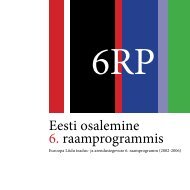Reactive Systems: Modelling, Specification and Verification - Cs.ioc.ee
Reactive Systems: Modelling, Specification and Verification - Cs.ioc.ee
Reactive Systems: Modelling, Specification and Verification - Cs.ioc.ee
Create successful ePaper yourself
Turn your PDF publications into a flip-book with our unique Google optimized e-Paper software.
Chapter 4<br />
Theory of fixed points <strong>and</strong><br />
bisimulation equivalence<br />
The aim of this chapter is to collect under one roof all the mathematical notions<br />
from the theory of partially ordered sets <strong>and</strong> lattices that is n<strong>ee</strong>ded to introduce<br />
Tarski’s classic fixed point theorem. You might think that this detour into some exotic<br />
looking mathematics is unwarranted in this textbook. However, we shall then<br />
put these possible doubts of yours to rest by using this fixed point theorem to give<br />
an alternative definition of strong bisimulation equivalence. This reformulation of<br />
the notion of strong bisimulation equivalence is not just mathematically pleasing,<br />
but it also yields an algorithm for computing the largest strong bisimulation over finite<br />
labelled transition systems—i.e., labelled transition systems with only finitely<br />
many states, actions <strong>and</strong> transitions. This is an illustrative example of how apparently<br />
very abstract mathematical notions turn out to have algorithmic content <strong>and</strong>,<br />
possibly unexpected, applications in Computer Science. As you will s<strong>ee</strong> in what<br />
follows, we shall also put Tarski’s fixed point theorem to good use in Chapter 6,<br />
where the theory developed in this chapter will allow us to underst<strong>and</strong> the meaning<br />
of recursively defined properties of reactive systems.<br />
4.1 Posets <strong>and</strong> complete lattices<br />
We start our technical developments in this chapter by introducing the notion of<br />
partially ordered set (also known as poset) <strong>and</strong> some useful classes of such structures<br />
that will find application in what follows. As you will s<strong>ee</strong>, you are already<br />
familiar with many of the examples of posets that we shall mention in this chapter.<br />
Definition 4.1 [Partially ordered sets] A partially ordered set (often abbreviated to<br />
85
















